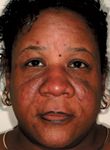- General Dermatology
- Eczema
- Chronic Hand Eczema
- Alopecia
- Aesthetics
- Vitiligo
- COVID-19
- Actinic Keratosis
- Precision Medicine and Biologics
- Rare Disease
- Wound Care
- Rosacea
- Psoriasis
- Psoriatic Arthritis
- Atopic Dermatitis
- Melasma
- NP and PA
- Skin Cancer
- Hidradenitis Suppurativa
- Drug Watch
- Pigmentary Disorders
- Acne
- Pediatric Dermatology
- Practice Management
- Prurigo Nodularis
Article
Skin of color: Studies lacking on rosacea in ethnic patients
Although there is a lot of ongoing research into rosacea and a number of FDA-approved medications, very little of either have to do with skin of color. Research protocols have not included ethnic skin, and medications were approved before the FDA required the inclusion of ethnic subjects.

Key Points

Studies on the prevalence of rosacea in skin of color and on the safety and efficacy of medications on rosacea in ethnic skin have not been done, says Valerie D. Callender, M.D., of Mitchellville, Md.

"We need to stimulate talk and concern and questions that can't be answered. That's how studies come about, how they evolve. A practice survey is currently under development to determine how common the diagnosis is in dermatology practices in the United States," Dr. Callender tells Dermatology Times.
Dr. Callender, a clinical assistant professor at Howard University and chairman of the American Academy of Dermatology Diversity Task Force, says one of the problems with the lack of information about rosacea in ethnic skin is that it can contribute to the misdiagnosis and underreporting of the disease.
"Because rosacea is not always thought to occur in patients of color, the No. 1 difference between its occurrence in Caucasian skin and skin of color is its misdiagnosis.
"If erythema occurs on the malar areas of the face, typically doctors - especially, general practitioners - tend to think about the butterfly rash of lupus, because lupus is seen commonly in skin of color.
"Doctors will often refer a patient to a rheumatologist for testing and treatment because they expect to see lupus - not rosacea. Then, when the tests come back negative, patients are sent to the dermatologist, who can see that the condition is rosacea," Dr. Callender says.
Darker pigments can also mask the presence of rosacea, making diagnosis more difficult, again, particularly for general practitioners.
"If a person has Fitzpatrick skin type V or VI, the erythema may not be appreciated. We've found that if patients of color don't present with signs of inflammation, many times they will present with either hypopigmentation, or, less often, with hyperpigmentation.
"So, a lightening of the skin on the cheeks can actually be a critical manifestation of rosacea in skin of color," Dr. Callender says.
Although rosacea can sometimes blend in and go unnoticed in skin of color, it shouldn't be ignored, she says.
"Patients can be symptomatic, meaning they get papules in the affected areas, and they have increased sensitivity to skincare products because of the rosacea. They can also have ocular rosacea, so it should be treated," she says.
Dr. Callender is also concerned because medications, both topical and oral, that are currently used to treat rosacea in skin of color were developed and approved by the Food and Drug Administration (FDA) for Caucasian skin.
"Basically, we use the same medications for all skin types. It's the same oral antibiotics, the doxycycline, tetracycline, minocycline family, metronidazole 1 percent, sodium sulfacetamide products, azelaic acid gel 15 percent, which all work very well.
"The problem is, we really have no clinical data looking at the safety and efficacy of the medications for patients of color," Dr. Callender says.





